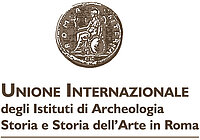L’École française de Rome a reçu le prix « Paestum Mario Napoli » 2023 pour ses 150 ans de recherche archéologique et de valorisation culturelle en Méditerranée. En savoir plus →
The École française de Rome (EFR) and the Centre Jean Bérard, archaeological excavation sites 2017-2121
The archaeological service
The archaeological service supports field operations carried out within the framework of the EFR’s research programmes. It offers the teams the possibility of availing themselves of qualified personnel (surveys, drawing, excavation, studies) and material means (information technology, topography, photography). This arrangement is completed by an archiving service that ensures the management and preservation of the graphic and photographic documentation of excavations.
The premises located at Piazza Navona, 62 offer a large area for research campaigns to study the material in which both students and researchers from Italian and French research centres and universities participate. The drawings office is integrated into the programme for help with the publication of archaeological work and gives “self-service” access to the computer graphics tools required for the acquisition, processing and printing of the different types of documents (drawings, photos, maps).
Lastly, this service ensures the coordination and realization of the excavation and study of the construction of the EFR building located at Piazza Navona, 62.
Permanent staff of the service:
- Audrey Bertrand, in charge of the archaeological service
- Évelyne Bukowiecki, in charge of the archaeological laboratory and of the follow-up of archaeological projects
-
Lorenzo Fornaciari, topografy and geomatics
History of the archaeological operations
The EFR worked essentially in the Maghreb from the end of the 19th century until the Second World War, first in Tunisia and Algeria and then in Morocco. It is still active there today within the framework of a cooperation supported by the [French] Ministry for Foreign Affairs. Before 1946 excavations in Italy were rare: the most important were those conducted in the Necropolis of Vulci in southern Etruria at the end of the 19th century (Stéphane Gsell), and in Bologna at the beginning of the 20th century (Albert Grenier), while several investigations were carried out during the same period at Portus in the vicinity of Ostia (Jérôme Carcopino). As from 1946, Italy became the theatre of regular operations: the excavation sites in Bolsena, Latium, to the north of Rome (begun by Raymond Bloch), as well as those of Megara Hyblaea in eastern Sicily (started by Georges Vallet and François Villard) were to prove very long-lived. After 1970 the problems and sites in Italy were more varied, from Friuli to Sicily, passing through Venice, Emilia-Romagna, Rome and Latium, the Abruzzi, Campania, Basilicata, Puglia, Calabria and Sardinia. Medieval archaeology is taking its place in Central Italy. The Centre Jean-Berard in Naples (CNRS/EFR) also conducts archaeological activities. Thus for more than a century numerous sites have been excavated, if we include the pursuit of activities in the Maghreb and the Balkans (the former Yugoslavia, then Croatia and Serbia, and more recently Albania).
Archaeological material, the property of the countries which receive us, remains in situ.
The results are published in EFR’s journal (MEFR until 1970, then MEFRA for Antiquity and MEFRM for the Middle Ages): annual archaeological reports exist in these journals. Some volumes have been published in the “Suppléments aux Melanges”, which in 1872 became the EFR’s “Collection”.
The EFR’s archaeological policy today is based on the following principles:
- working within the framework of a partnership, taking into account the requirements of the host country and its situation in the domains of patrimony and research
- getting French experts to work who can make an original contribution (funereal anthropology, work on ancient crafts, the functioning of the paleo-environment)
- contributing to training in research for young researchers (doctoral and post-doctoral students)
- publishing the results of completed excavations.
Aid for archaeological work
The archaeological work supported by the EFR for a quarter of a century corresponds to 40 dossiers awaiting publication. A special effort is thus being made to accelerate the implementation of this work under way.
This concerns in particular:
- the excavation of the River Port of Aquileia, begun in 1991 and completed in the field in 2005
- the excavation of the Celtic-Etruscan Necropolis of Monterenzio Vecchio, carried out in six campaigns between 2000 and 2005
- the excavation of Musarna, a small town in the locality of Tarquinia (southern Etruria), carried out from 1983 to 2002
- preventive archaeological research carried out on the Pincio from 1982 to 2005
- the planned excavation of the Vigna Barberini on the Palatine Hill, carried out from 1985 to 1998
- the excavation of various sectors of Paestum-Poseidonia in Campania
- the excavation of the small Lucanian town of Tricarico in Basilicata
- the excavation of Megara Hyblea in Sicily
- the excavation of two Tunisian sites, the Necropolis of Pupput and the Sidi Jdidi complex
- the excavation of the sites of Salona in Croatia and of Sirmium and Caricin Grad in Serbia
For further information
The Mélanges of the EFR (for Antiquity MEFRA and MEFRM for the Middle Ages) contain a chronicle of the archaeological activities under way which may be consulted on the Persée site for volumes before 2000, or on the site of the publisher Casalini for volumes from 2000 to 2011.
The Chronique des activités archéologiques of the EFR presents reports of the archaeological operations with which the EFR is associated or which are conducted by French teams in Italy, in North Africa and in the Balkans. Those in charge of the operations present in it the preliminary results of their archaeological research, from Prehistory to the end of the Middle Ages. La Chronique, previously published in the Mélanges de l’École française de Rome, since 2012 has been a stand-alone electronic publication with a continuous flow of information.
Personnel permanent du service
- Audrey Bertrand, responsable du service archéologique
- Evelyne Bukowiecki, responsable du laboratoire d'archéologie et du suivi des projets archéologiques
-
Lorenzo Fornaciari, topographe-géomaticien
L'archéologie en vidéo
Les sites en cours de fouilles par l’EFR
ALBANIE
CROATIE
ITALIE
- Cimitero di Atella (Basilicate)
- Civita di Tricarico et Serra del Cedro (Basilicate)
- Siris-Héraclée (Basilicate)
- Ischia (Campanie)
- Porta Nocera, Pompéi (Campanie)
- San Severino Marche (Marches)
- Mégara Hyblaea (Sicile)
SERBIE
TUNISIE
Les fouilles passées de l’EFR
- Archipel du Kvarner (Croatie)
- Carthage (Tunisie)
- Civita Musarna (Italie)
- Jebel Oust (Tunisie)
- Kouass (Maroc)
- Levanzo (Italie)
- Martinšćica (Croatie)
- Mirine-Fulfinum (Croatie)
- Nécropole de Santa Rosa, Rome (Italie)
- Palatin, Rome (Italie)
- Piazza Navona, Rome (Italie)
- Pincio, Rome (Italie)
- Pistrina, Pompéi (Italie)
- Portus, Rome (Italie)
- Poseidonia/Paestum (Italie)
- Valle Giumentina (Italie)
- Vestins (Italie)













